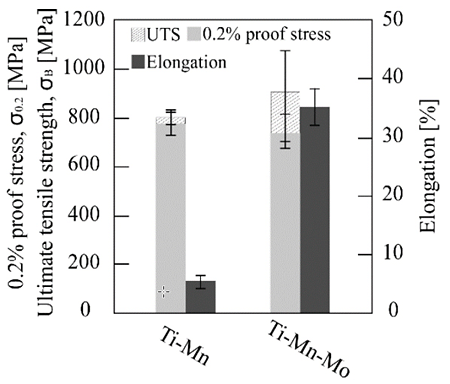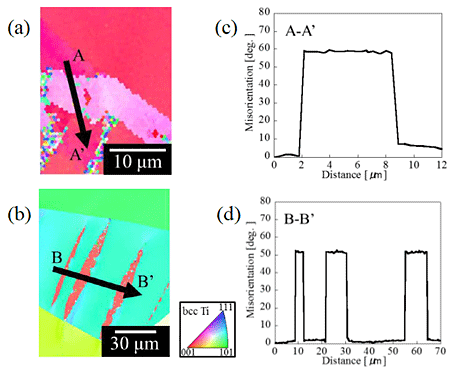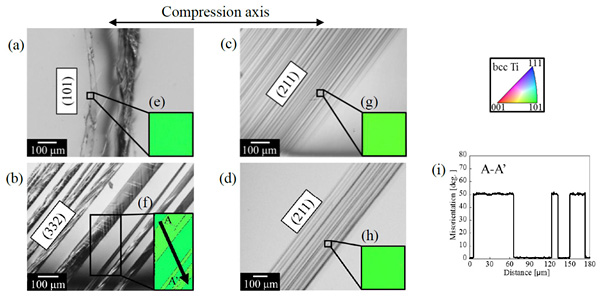The influences of Mo addition on the tensile properties and deformation behavior of β-type Ti-Mn alloys were investigated with particular focus on {332}<113> deformation twinning. The elongation of Ti-Mn alloys are increased from approximately 5% to 30% by Mo addition, with maintaining ultimate tensile strength of 900 MPa. The excellent strength-ductility balance of Ti-Mn-Mo alloys is caused by {332}<113> twinning. Moreover, we found for the first time that CRSS for {332}<113> twinning in Ti-Mn-Mo alloy was lower than that in Ti-Mn alloy. This results suggest that CRSS for {332}<113> twinning in the alloy is decreased by Mo addition.
The tensile strength and elongation of Ti-Mn and Ti-Mn-Mo polycrystals are shown in Fig. 1. Ti-7Mn and Ti-5Mo-3Mo alloys exhibit completely different tensile properties. Ti-5Mn-3Mo alloy exhibits higher ultimate tensile strength and high elongation than Ti-7Mn alloy.
Figure 2 shows inverse pole figure (IPF) maps and misorientation profiles along the arrow in the IPF maps of Ti-Mn and Ti-Mn-Mo polycrystals tensile deformed to fracture. In Ti-Mn alloy, the misorientation angle between the matrix and the defamation band is approximately 60°, suggesting that {112}<111> deformation twinning takes place in the alloy during the tensile deformation. In contrast, the deformation bands show misorientation angle of approximately 50.5° in Ti-Mn-Mo alloy. Thus, the deformation mode for the alloy is identified as {332}<113> twinning. These results indicate that the deformation mode of Ti-Mn alloy is changed from {112}<111> twinning to {332}<113> twinning by Mo addition.
Figure 3 shows the optical micrographs and the IPF maps of Ti-Mn and Ti-Mn-Mo single crystals compressed to total strain of 2% along [238] or [367] orientations, respectively. It is noted that the deformation mode which has highest Schmid factor at [238] or [367] orientations is {332}<113> twinning or {112}<111> twinning/slip, respectively. As shown in Figs. 3 (a) and (e), {110}<111> slip is occurred in Ti-Mn single crystal compressed along [238] orientation. Noted that the {110}<111> slip has second highest Schmid factor at [238] orientation. This result suggest that the critical resolved shear stress (CRSS) for {332}<113> twinning is higher than that for {110}<111> slip in Ti-Mn alloy. On the other hand, {332}<113> twinning is observed to occur in Ti-Mn-Mo alloy compressed along same orientation (Figs. 3 (b), (f) and (i)). In both Ti-Mn and Ti-Mn-Mo single crystals deformed at [367] orientation, {112}<111> slip which has the highest Schmid factor is observed to occur (Figs. 3 (c), (d), (g), and (h)). Table 1 shows the CRSS for {332}<113> twinning and {112}<111> slip in study alloys. The CRSS for {332}<113> twinning is higher than that for {112}<111> slip in Ti-Mn alloy. Therefore, one can conclude that the slip deformation is easier to occur than {332}<113> twinning in the alloy. It should be noted that the CRSS for {332}<113> twinning is lower than that for {112}<111> slip in Ti-Mn-Mo alloy. These results suggest that Mo addition is effective in decreasing CRSS for {332}<113> twinning and inducing {332}<113> twinning in Ti-Mn alloys.



